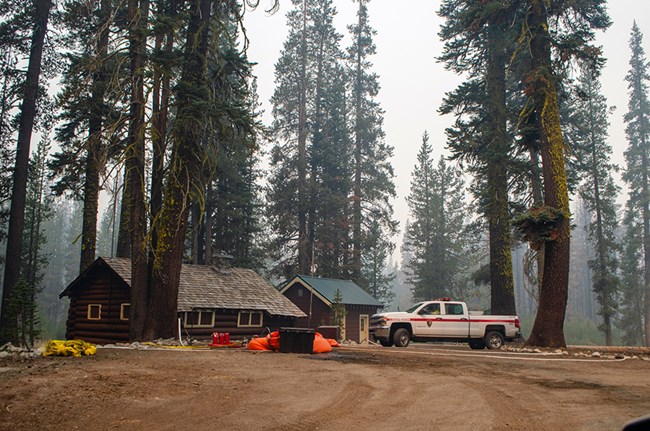Last updated: December 20, 2021
Article
Previous Fuel Treatments Around Park Infrastructure Assist Firefighters During Dixie Fire at Lassen Volcanic National Park

NPS
Lassen Volcanic National Park’s fuels management program has long prioritized creating defensible space around park infrastructure. This led to success during the 2021 Dixie Fire when some park infrastructure was determined to be safe for firefighters for both access to control lines as well as good escape routes.
Previous fuels treatments around the Summit Lake Campground and ranger station aided firefighters because the reduction in fuel loading moderated fire behavior, allowing firefighters to safely guide the fire around the structures in the area. The previous thinning, chipping, and burning of small-diameter trees around the ranger station also meant that sprinklers could achieve better coverage of both the structure and surrounding fuels.
However, during the Dixie Fire, much of Lassen Volcanic National Park’s infrastructure was unable to be staffed by firefighters. Among the myriad reasons for this, firefighting resources were allocated to higher priority areas such as communities at risk, or structures were determined to be unsafe for firefighters to staff because of the fast-moving fire, remote locations of the structures, and long escape route times. While several structures within the park were destroyed, previous fuels treatments more than likely played a role in some unstaffed structures being undamaged by the Dixie Fire as it burned around them. Near the Juniper Lake Ranger Station, small diameter trees, along with dead and down debris, were cut, piled, and burned prior to the Dixie Fire, leaving an area with little surface fuel and no ladder fuels. While there are many factors that contribute to how an area burns during a wildfire, previous fuel treatment around the Juniper Lake Ranger Station likely contributed to it still standing today.
Large-scale wildfires like the Dixie Fire take on a life of their own, but contemporary hazard fuel reductions projects work to preserve infrastructure. Recent defensible space projects, as well as pile burning and prescribed fires, not only give firefighters opportunities to protect historical assets for future generations, it gives structures a fighting chance and makes it safer for firefighters during massive unwanted wildfires.
